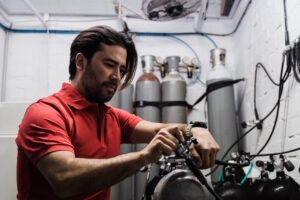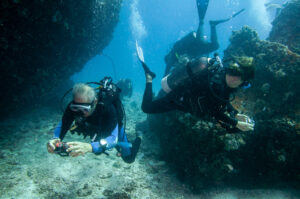What is Half Time?
Half time in scuba diving is a critical concept used to understand and manage the absorption and release of inert gases in the body during diving activities. Specifically, it refers to the time it takes for a particular tissue compartment in the body to absorb or eliminate half of the difference between the existing level of inert gas and the new equilibrium level. This concept is foundational for safe diving practices as it aids in determining appropriate decompression procedures to avoid conditions like decompression sickness (DCS).
Historical Development and Conceptual Foundations
The understanding of half time in scuba diving has evolved significantly since its inception. The concept dates back to the early 20th century when pioneering research in decompression theory began. The initial studies were driven by the need to ensure the safety of divers, particularly those involved in military and commercial operations.
One of the earliest contributors to the field was John Scott Haldane, a Scottish physiologist, who in the early 1900s developed the first scientific decompression tables. Haldane’s work was based on the idea of “critical supersaturation” and introduced the concept of tissue compartments, each with different half times. His tables, created for the British Royal Navy, were designed to minimize the risk of decompression sickness by controlling the rate at which nitrogen was allowed to leave the body.
Over the decades, further research refined these concepts. Notable advancements included the work of Albert Bühlmann, who developed algorithms incorporating multiple tissue compartments with varying half times. Bühlmann’s ZH-L (Zurich-Haldane) models have been widely adopted and form the basis of many modern dive computers and decompression tables. The progression from simple to more complex models reflects the increasing understanding of how inert gases interact with the body under pressure.
Theoretical Background
Half time represents a key element in the physiological models used to predict gas exchange in the body’s tissues. When a diver descends, the increased pressure causes inert gases, such as nitrogen or helium, to dissolve into the body’s tissues at a rate dependent on the depth and duration of the dive. Each tissue type, categorized into theoretical compartments, absorbs and releases these gases at different rates, defined by their respective half times.
The half time of a tissue compartment is the time required for it to reach 50% of the total gas saturation it would achieve if exposed indefinitely to a particular pressure. For instance, if a compartment has a half time of 20 minutes, it means that in 20 minutes, the tissue will absorb half of the gas needed to reach equilibrium at that depth. Another 20 minutes would bring the total to 75% of equilibrium, and so on, approaching but never quite reaching full saturation.
Decompression models typically use multiple compartments, each with its own half time, to simulate the body’s varied response to pressure changes. These compartments range from fast tissues with short half times (e.g., 5 minutes) to slow tissues with long half times (e.g., 120 minutes or more). Fast tissues absorb and release gases quickly, making them critical in short, deep dives, while slow tissues are more relevant in long, shallow dives. The interplay between these compartments helps in understanding and predicting the safe limits of dive profiles and ascent rates.
Practical Applications
In practical terms, the concept of half time is indispensable for planning safe diving profiles. Divers and dive planners use half times to estimate how long a diver can stay at a given depth without exceeding safe limits for inert gas absorption. This information is critical for calculating no-decompression limits (NDLs), which indicate the maximum time a diver can spend at a certain depth without requiring decompression stops during ascent.
For example, consider a diver planning a series of dives over a day. By understanding the half times of different tissue compartments, the diver can calculate the residual nitrogen levels in their body between dives. This calculation helps in determining safe surface intervals and whether decompression stops will be necessary for subsequent dives.
Dive tables and dive computers are the primary tools that apply these principles in practical settings. Dive tables, like those developed by the United States Navy or the Bühlmann tables, provide pre-calculated profiles for various depths and durations based on tissue half times. Dive computers, on the other hand, perform real-time calculations, adjusting for actual dive profiles and providing more flexibility and accuracy. They continuously track a diver’s depth and time, applying complex algorithms to ensure that divers stay within safe limits based on their current and historical dive data.
Understanding half times is also crucial in managing repetitive dives, where residual inert gases from previous dives impact the allowable bottom time of subsequent dives. For instance, a diver who has spent considerable time at depth will need to consider the slower compartments’ half times to ensure they have adequately off-gassed before diving again.
Half Time in Modern Dive Computers
Modern dive computers have revolutionized the application of half time concepts, enhancing both the safety and convenience of diving. These devices integrate sophisticated algorithms that continuously monitor a diver’s profile, automatically calculating and updating inert gas levels in real-time. This technology allows for more personalized and accurate dive planning compared to traditional dive tables.
Dive computers use a range of tissue compartments with different half times, often based on Bühlmann’s ZH-L models or similar algorithms. These devices provide real-time data on no-decompression limits, ascent rates, and decompression stops, adjusting dynamically as the diver changes depth. The continuous monitoring and recalculation help prevent decompression sickness by ensuring divers adhere to safe ascent profiles.
The ability to input personal parameters, such as age, physical condition, and previous dive history, further tailors the calculations to individual divers. Some advanced dive computers also incorporate factors like water temperature and workload, which can affect gas absorption rates. These personalized adjustments are made possible by understanding and applying the principles of half times, ensuring divers have the most accurate and safe information at their disposal.
In addition to safety, dive computers enhance the diving experience by providing a wealth of information. Divers can access detailed logs of their dive profiles, including depth, time, and ascent rates. This data is invaluable for reviewing dive performance and planning future dives. The integration of half time calculations into these devices exemplifies how technology can leverage scientific principles to improve both safety and enjoyment in diving.
Half Time and Safety Considerations
Understanding half time is essential for ensuring diver safety. One of the primary risks in diving is decompression sickness, which occurs when inert gases form bubbles in the body’s tissues during ascent. Properly managing half times helps mitigate this risk by guiding divers on safe ascent rates and decompression procedures.
One common misconception is that divers can ascend quickly as long as they stay within no-decompression limits. However, even within these limits, ascending too quickly can lead to bubble formation, especially in slower compartments that retain inert gases longer. Therefore, adherence to recommended ascent rates, typically 9 meters (30 feet) per minute or slower, is crucial. This rate allows tissues to off-gas safely, minimizing the risk of DCS.
Another safety consideration is the use of safety stops, usually performed at 3-5 meters (10-15 feet) for 3-5 minutes at the end of a dive. Safety stops provide additional time for off-gassing, particularly for slower tissues with longer half times. Although not always mandatory, safety stops are a prudent measure, especially after deep or prolonged dives.
Divers must also be aware of factors that can affect gas absorption rates. Physical exertion, cold water, and dehydration can increase inert gas uptake, altering the effective half times of tissues. Dive computers that incorporate these factors into their calculations provide a more comprehensive safety net by adjusting decompression profiles in real-time.
Furthermore, understanding residual nitrogen levels and their impact on repetitive dives is critical. Divers should use dive tables or computers to ensure they have adequately off-gassed between dives. Ignoring residual nitrogen can lead to cumulative effects, increasing the risk of DCS over multiple dives. By applying the principles of half time, divers can make informed decisions, reducing the likelihood of decompression-related injuries.
Key Takeaways
The concept of half time is fundamental to safe scuba diving, underpinning the calculations that ensure divers avoid decompression sickness. From its historical development to its application in modern dive computers, understanding half time helps divers plan their activities safely and effectively. By considering the varied absorption rates of different tissues, divers can manage their ascent rates, decompression stops, and repetitive dives, significantly enhancing their safety and overall diving experience.

















